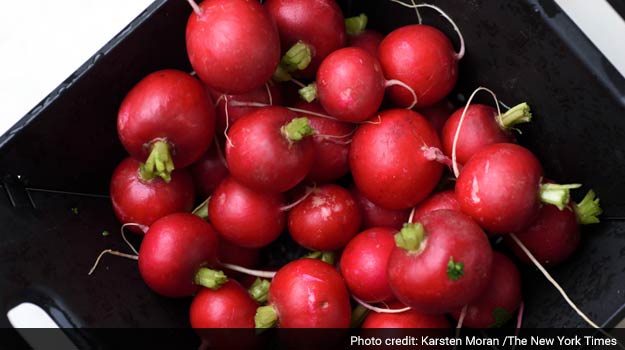It’s that time of year again, on the East Coast at least, when spring is in the air but not in your shopping basket.
Cooks in more-temperate climes may be enjoying peas and asparagus. Here, if you want your vegetables to be local and seasonal, you’ll have to wait a bit longer. The spring equinox doesn’t guarantee warm weather, at least not immediately.
I don’t mind holding off. There is still much to be done with end-of-winter vegetables. Try baking whole beets, skin on, and treating them like baked potatoes. Scrub them well and bake them for an hour or so, until they are truly soft. Then split them and garnish halves with a pat of butter, a spoonful of crème fraîche and a shower of snipped chives. Or add other fresh herbs, like tarragon or chervil. (Strictly speaking, fresh herbs don’t fit the local and seasonal definition, but using them is a way to brighten winter vegetables and make them feel more like spring.)
Parsnips are a personal favorite I’m loath to give up. Peeled, chopped and briefly simmered, they are delicious sautéed with brown butter and lemon, topped with a classic gremolata of chopped parsley, garlic and lemon zest.
Steamed kabocha squash with sake and miso is a delightful dish that can happily carry on well into spring. It can be served hot or cold, and is a snap to prepare.
With Easter and Passover on the way, I have been playing with this not-quite-spring challenge - since there must be vegetables on the table to accompany the ham, lamb or brisket - and came up with three colorful dishes.
Red radishes, though we think of them as part of a crisp raw crudité platter, are delicious cooked. Simply simmer them in a buttery bath, and they’re ready in minutes. Sprinkle with dill, and voilà. If you’re a fan of baby turnips, you’ll be happy with radishes as a stand-in.
Cauliflower provides a blank canvas, willingly submitting to transformation - cheesy, spicy or otherwise. For a gilded approach, cook it in olive oil in a quasi-Venetian way. Saffron, cinnamon, onions, raisins and pine nuts give it a most festive look and taste.
And what to do with humble carrots? Roasting them with coconut oil gives incredible results for hardly any effort. To complement the sweetness and fragrance, add chopped jalapeño, mint and cilantro along with a squeeze of lime. This combination is well worth repeating.
Even if these vegetables are on their way to last-season status, there’s no reason they should be lackluster.
Venetian Cauliflower
Time: 30 minutes
Yield: 6 servings
1 cauliflower, about 1 1/2 pounds
4 tablespoons olive oil
1 large onion, finely diced
Pinch of saffron, crumbled
1/8 teaspoon ground cinnamon
1/2 teaspoon fennel seeds, crushed
1/2 teaspoon whole coriander seeds
Pinch of crushed red pepper
Salt and pepper
1/2 teaspoon lemon zest
1/4 cup currants
1/2 cup golden raisins
1/4 cup pine nuts, lightly toasted
2 tablespoons chopped parsley
1. Cut cauliflower in half from top to bottom, then remove the core. With a paring knife, cut into very small florets of equal size. Blanch florets in boiling water for 2 minutes. Cool in cold water and drain.
2. Put olive oil in a wide skillet over medium heat. Add onion and cook, stirring, until softened and lightly browned, about 10 minutes. Add saffron, cinnamon, fennel seeds, coriander seeds and red pepper. Season well with salt and pepper.
3. Add lemon zest, currants, raisins and cauliflower florets. Toss with wooden spoons to distribute. Cover with a lid and cook for about 5 minutes more, until cauliflower is tender. Transfer to a serving dish and sprinkle with pine nuts and parsley. Serve warm or at room temperature.
Roasted Coconut Carrots
Time: 30 minutes
Yield: 6 servings
1 1/2 pounds medium carrots
Salt and pepper
2 tablespoons coconut oil, melted
1 jalapeño, finely chopped (seeds removed if desired)
2 tablespoons chopped mint
1 cup roughly chopped cilantro leaves and tender stems
1 lime, halved, plus lime wedges for garnish
1. Heat oven to 400 degrees. Peel carrots and cut into 2-inch batons. Season well with salt and pepper, and drizzle with coconut oil. Spread them on a baking sheet and roast, uncovered, until carrots are lightly browned and tender when pierced, 20 to 25 minutes. (Carrots may be roasted in advance and reheated if desired.)
2. Transfer hot carrots to a serving dish. Add jalapeño and mint and toss to distribute. Sprinkle with cilantro and squeeze lime juice over everything. Garnish with lime wedges.
Butter-Stewed Radishes
Time: 30 minutes
Yield: 6 servings
1 1/2 pounds red radishes, about 3 bunches
Salt and pepper
6 tablespoons butter (3/4 stick)
3 tablespoons dill or parsley, freshly chopped
1. Trim the tops from the radishes, leaving 1/4 inch of green stem. Cut off the roots at the base of each radish, then cut radish in half from top to bottom. Soak radishes in a large bowl of lukewarm water, agitating them to loosen any clinging sand. Drain and rinse, then soak them in cold water. Soak and rinse a third time if necessary.
2. Put radishes in a wide skillet and season well with salt and pepper. Add butter and 1 cup of water and bring to a boil over high heat. Cover and reduce heat to a brisk simmer. Cook radishes until tender when pierced, but no further, about 5 minutes.
3. Remove lid, raise heat and boil to evaporate most of the liquid. Serve in the buttery juices with a sprinkling of dill.
© 2015 New York Times News Service
Advertisement
For the latest food news, health tips and recipes, like us on Facebook or follow us on Twitter and YouTube.
Tags:





